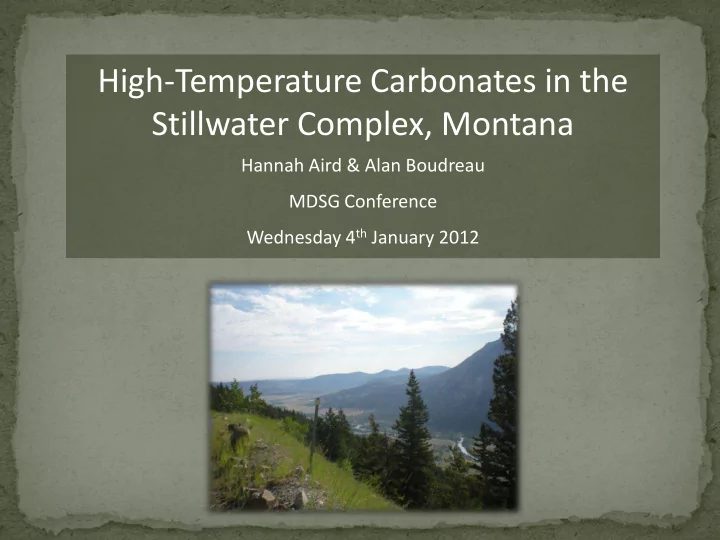

High-Temperature Carbonates in the Stillwater Complex, Montana Hannah Aird & Alan Boudreau MDSG Conference Wednesday 4 th January 2012
Stillwater Complex Map of the Stillwater Complex showing relevant outcrops. Samples were collected from West Fork, Mountain View, the Minneapolis Adit, Picket Pin and the section between Contact Mountain and Chrome Mountain. After McCallum (1996).
Evidence for Fluids in the Stillwater Complex • Pegmatites • Inclusion Studies • Volatile-rich Mineral Phases J-M Reef Low T Carbonates High T Carbonates After Boudreau & McCallum, 1992
Low Temperature Carbonates A q cz chl cc pn py plag 50 μ m 25 μ m 25 μ m plag B cc q 200 μ m 200 μ m 125 μ m A: Association of calcite with greenschist minerals clinozoisite/epidote and chlorite. Sample from gabbronorite zone I. Plag, plagioclase; chl, chlorite; cc, calcite; q, quartz; cz, clinozoisite; pn, pentlandite; py, pyrite. B : Sample from a calcite vein encrusting orthopyroxenite in bronzitite zone. Cc, calcite; plag, plagioclase; q, quartz.
High Temperature Carbonates A opx Ca-rich px dm po cc cp 40 μ m 25 μ m 25 μ m 25 μ m 25 μ m 50 μ m B pn q py py po dm cpx cc opx Exsolution in sulphide-proximal carbonates, associated with little silicate alteration. Rim of clinopyroxene around sulphide-carbonate assemblage. A : Sample from peridotite zone. B : Sample from gabbronorite zone I. Cpx, clinopyroxene; opx, orthopyroxene; dm, dolomite; cc, calcite; po, pyrrhotite; py, pyrite; cp, chalcopyrite; pn, pentlandite; q, quartz
Carbonate Exsolution A B B: A carbonate inclusion in forsterite from a region of high grade marbles in East Antarctica Cp (Mizuochi et al, 2010) Dol Po Cc Ca-rich px Opx A: Carbonates in association with sulphide minerals. Calcite appears to have exsolved from dolomite. Carbonates and sulphides are associated 50 µm with high temperature silicates that display no obvious alteration.
Calcite-Dolomite Geothermometer Inset (below) demonstrates the recombination of exsolved calcite and dolomite end members in a sulphide- proximal carbonate. After Anovitz & Essene (1987) Calcite-Dolomite solvus (after Anovitz & Essene. 1987) with nine Stillwater samples plotted by composition. For vein samples, the range of data (line) and the average (dot) are shown. For sulphide-associated samples, the value calculated by recombination of exsolved calcite and dolomite end members is shown (star) with the error (line). For occurrences of calcite in veins and in granophyre, temperatures have been estimated by composition (shown by dashed line).
Fluid Inclusion Studies (Hanley et al, 2008) Minimum Trapping Conditions: 4.3-5.6kbar 700-715 ° C 10 μ m 10 μ m
Pyroxene Geothermometer Two Pyroxene Geothermometer (after Lindsley & Andersen, 1983) with Stillwater samples plotted by composition. Data from OB-III and OB-IV pyroxenes (Meurer & Boudreau, 1996) for comparison. All temperatures in degrees Celsius. Inset (right) shows an example of carbonate-proximal clinopyroxene within the host orthopyroxene.
Possible FeO Geothermometer Plot of molar % FeO against temperature ( ° C). Plotted are compositional data of carbonatitic, marble and secondary carbonates from the literature for comparison with Stillwater samples. Most Stillwater data plots within the same range as the carbonatite samples.
Possible MnO Geothermometer Plot of molar % MnO against temperature ( ° C). Plotted are compositional data of carbonatitic, marble and secondary carbonates from the literature for comparison with Stillwater samples. Most Stillwater data plots within the same range as the carbonatite samples.
CaCO 3 -H 2 O-NaCl System CaCO 3 Calcite + Fluid Initial carbonatitic fluid F 1 Two Fluids F 2 Late hydrous Halite fluid Extrapolated from + Fluid Newton and Manning (2002) NaCl H 2 O
Conclusions High-temperature carbonates: • Little low temperature (greenschist) alteration • Associated with sulphides • Exsolution of calcite from dolomite • Rim of Ca-poor clinopyroxene • Carbonate geothermometer data consistent with two-pyroxene geothermometer and fluid inclusions Implications: • Provides further information on fluid composition • Fluids have potential for PGE transport
Acknowledgements Advisor: Field Assistance: • Dr Alan Boudreau • Malia Lehrer • Jordan Jarrett • Stacey Worman Committee: • Dr Emily Klein • Dr Drew Coleman Other: • Dr Paul Baker • Dr James Scoates • Corey Wall
Questions?
Recommend
More recommend